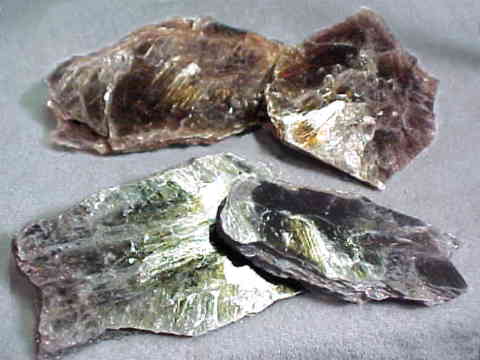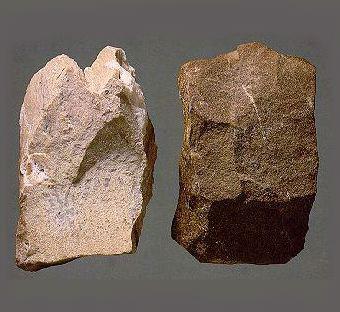Related Flashcards
Related Topics
Cards In This Set
| Front | Back |
|
Amphibole |
Ca2(Fe,Mg,Al)5(Si,Al)2Si6O22(OH)2[hydrous calcium, iron/magnesium, aluminum silicate ]
H = high, but very close to the hardness of glass (6); C = present, often with "stair-step" pattern; S.G. = 3.4; highly reflective glassy luster; very dark or black. Hornblende is the most common member of this mineral group. |
 Biotite |
K(Fe,Mg)3(AlSi3O10)(OH)2[ hydrous potassium, iron/magnesium, aluminum silicate ]
H = medium (2.5 to 3); C = present, splits in thin flexible sheets; S.G. = 3.0; very glassy luster; dark brown to black in color; a variety of mica. |
 Plagioclase |
(Ca,Na)Al(Al,Si)Si2O8[ calcium/sodium aluminum silicate]
H = high (6); C = present; S.G. = 2.6; glassy luster; dark colors (gray to black); perfectly parallel striations on some cleavage faces. Economic use: Used in ceramics. |
 Garnet |
(Ca,Fe,Mg)3Al2Si3O12[ calcium/iron/magnesium aluminum silicate ]
H = high (6.5 to 7.5); C = none; S.G. = 3.5-4.3; glassy luster; wine-red color is common; commonly found in irregular masses, or as 12-sided, equant crystals. Economic use: Used as a gemstone and an abrasive. |
 Kaolinite |
Al2Si2O5(OH)4[ hydrous aluminum silicate ]
H = low (2); C = not observed; S.G. = 2.6; massive; dull luster; white. Economic use: Used in ceramic products and Kaopectate. |
 Muscovite |
KAl3Si3O10(OH)2[ hydrous potassium, aluminum silicate ]
H = low to medium (2 to 2.5); C = present, splits in thin flexible sheets; S.G. = 2.8;glassy luster; clear to light color; a variety of mica. Economic use: Used as an insulator for heat and electricity. |
 Olivine |
(Fe,Mg)2SiO4[ iron/magnesium silicate ]
H = high (7); C = none; G = 3.5-4.5; glassy luster; usually a shade of green; commonly occurs in massive aggregates of small, equant crystal grains. |
 Potassium Feldspar |
KAlSi3O8[ potassium aluminum silicate ]
H = high (6 to 6.5); C = present; S.G. = 2.6; glassy to dull luster; many colors, but usually white, grey to salmon pink; indistinct color-banding seen on cleavage faces (not to be confused with plagioclase striations). Economic use: Used in ceramics. |
 Pyroxene |
Ca(Fe,Mg)Si2O6[ calcium, iron/magnesium silicate ]
H = high, but close to the hardness of glass (6); C = present; S.G. = 3.5; glassy to dull luster; dark color, often greenish. |
 Quartz |
SiO2[ silica (or silicon dioxide) ]
H = high (7); C = none, well-developed conchoidal fracture; glassy luster; clear, light, or dark gray color. Different varieties:Rock Crystal Quartz: colorless; occurs as 6-sided prismatic crystalsMilky Quartz: milky white; massiveRose Quartz: light pink or rose colored; massiveSmoky Quartz: gray to black; massive Economic use: Used in electronics industry and in glass making. |
 Talc |
(Fe,Mg)3Si4O10(OH)2[ hydrous iron/magnesium silicate]
H = low (1); C = present, but often not observed; S.G. = 2.8; pearly to dull luster; white, gray, or shade of green; soapy feel. Economic use: Used in talcum powder and cosmetics. |
|
Calcite |
CaCO3
[ calcium carbonate ] H = medium (3); C = present, single cleaved specimens are rhombohedral in shape; S.G. = 2.7; glassy to dull luster; any color, often white or clear; effervesces immediately and strongly in HCl. Economic use: Used in making cement. |
 Dolomite |
CaMg(CO3)2
[calcium, magnesium carbonate ] H = medium (3.5 to 4); C = present, single cleaved specimens are rhombohedral in shape; S.G. = 2.8; glassy luster; any color; powder effervesces in HCl. |
 Malachite |
Cu2(CO3)(OH)2
[ hydrous copper carbonate ] H= medium (3); C = none; glassy to dull luster; commonly massive; always shades of dark rich green; weak effervescence in HCl. Economic use: Gem mineral, jewelry and ornamental material; ore of copper. |








